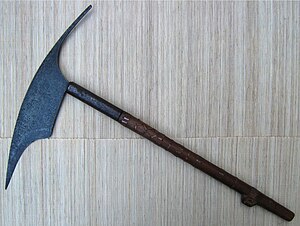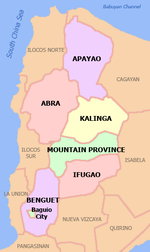Igorot head ax
| Igorot head ax | |
|---|---|

|
|
| Information | |
| Weapon type: | Axe |
| Designations: | Head-Ax, Kalinga Head-Ax, Igorot Ax |
| Use: | Weapon, traditional weapon, tool |
| Working time: | til today |
| Region of origin / author: |
Philippines , Igorot tribes (Bontok, Ibaloy, Ifufao , Isneg, Kalinga and Kankanaey) on the island of Luzon |
| Distribution: | Philippines |
| Overall length: | approx. 25 - 58 cm |
| Blade length: | approx. 22 - 33 cm |
| Blade width: | approx. 8 - 13 cm |
| Handle: | Wood, metal |
| Particularities: | The Igorot ax was used in combat, especially in headhunting . |
| Lists on the subject | |
The Kopfaxt is a battle-ax of the Igorot strains in the mountain province of the Philippine Cordillera Central on the island of Luzon .
Alternative names are: Igorot battle ax , Igorot ax , Head-Ax , Kalinga Head-Ax , Bontoc battle ax .
history
The Igorot developed this ax as a weapon and tool. Igorot is a collective name for various ethnic groups, including Bontok (also Bontoc), Ibaloy , Ifugao , Isneg , Kalinga and Kankanaey (also Kananai). They got their name from the headhunting tribes who used this ax. These axes are still carried today by tradition. The majority of ax production z. B. the Bontok-Igorot came to neighboring tribes; In addition to axes, the bolo knife was also common among the southern Bontok .
description
The axes have a smooth blade that is concave or straight at the cutting edge . The upper side of the blade is slightly curved, the lower one straight. Opposite the cutting edge it has a pointed punch . The blade is of uniform thickness. The ax handle is usually made of metal or wood. It is thinner at the bottom than at the eye.
The rear punch can be driven into the ground for use as a work tool. Since the ax is now fixed, you can cut different materials on the cutting edge.
There are two types of this ax that can be easily distinguished. The axes of the northern ethnic groups are concave on the blade, those of the southern straight. According to Albert E. Jenks (1905), there were two main villages in the Bontok region in the early 20th century where these weapons were manufactured. The northern axes were made in Balbelasan : they have the concave edge shape and a longer handle; the southern ones in Baliwang : they have a shorter stem and a rather straight, slightly sloping edge.
Right: three Igorot axes, left: three Barong swords
The blade is about 30 cm long, the ax handle about 40 cm.
The Igorot did not get the iron needed for forging from their own quarrying, but used Chinese iron bars and broken iron in earlier times.
The African Manzhi ax bears a certain resemblance.
literature
- Albert Ernest Jenks: The Bontoc Igorot. (Department of the Interior: Ethnological Survey Publications. 1). Manila 1905. ( online in Digitale-sammlungen.de ). See pp. 125–130, chapter Metal Weapons with a brief description of forging technology.
- Herbert W. Krieger: The Collection of Primitive Weapons and Armor of the Philippine Islands in the United States National Museum. (= United States National Museum Bulletin. 137). Smithsonian Institution, Washington, DC 1926.
- George Cameron Stone : A Glossary of the Construction, Decoration, and Use of Arms and Armor in All Countries and in All Times. Together with Some Closely Related Subjects. Southwork Press, Portland, Maine 1934, pp. 288-289. (Reprint: Dover Publications, Mineola, New York 1999, ISBN 0-486-40726-8 , limited preview in Google Book Search).
Web links
- Head-Ax in Pitt's Rivers Museum, Oxford, inventory no. 1954 March 16 , English, accessed September 29, 2012
Individual evidence
- ^ Albert E. Jenks: The Bontoc Igorot. Manila 1905 S. 129th .
- ^ Herbert W. Krieger: The Collection of Primitive Weapons and Armor of the Philippine Islands in the United States National Museum. 1926, plate 10.
- ^ Herbert W. Krieger: The Collection of Primitive Weapons and Armor of the Philippine Islands in the United States National Museum. 1926, plate 18.
- ↑ George Cameron Stone: A Glossary of the Construction, Decoration and Use of Arms and Armor. Portland 1934, p. 288.
- ^ Albert E. Jenks: The Bontoc Igorot. Manila 1905 S. 126th .



